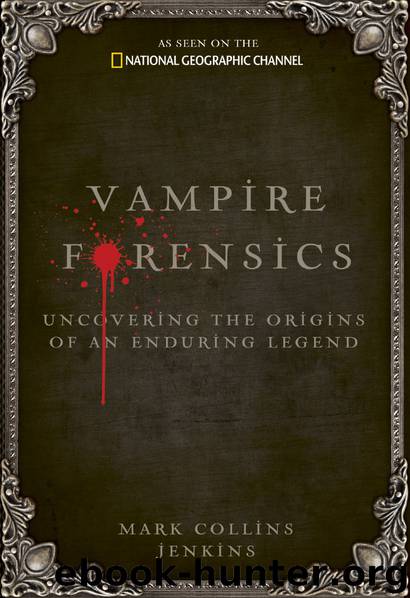Vampire Forensics by Mark Collins Jenkins

Author:Mark Collins Jenkins
Language: eng
Format: epub, mobi
Publisher: National Geographic Society
Published: 2009-12-14T16:00:00+00:00
WITCHES AND WEREWOLVES
In 1484, Pope Innocent VIII issued a papal bull making witchcraft a heresy in Catholic Europe. Yet, the hysteria that overtook Europe in the 16th and 17th centuries, when 30,000 to 60,000 people were burned at the stake, never really ignited in the Slavic east. There the witch was, more often than not, the village “wise woman.” The horseshoes, hares’ heads, and boars’ tusks nailed on walls and barns, or the garlic cloves, blue beads, and bloodstones that decorated houses, horses, and caps were as much a defense against the evil eye—the intense gaze, the unblinking stare, the envious glance—as they were charms against witches or vampires. Anyhow, in folklore, witches and vampires were often the same thing.
In Romania, strigoi are vampires, while strigele are the spirits of witches. In Italy, strega are witches or vampires, as the occasion demands. Both shared the same attributes: Witches were said to have long teeth, their bodies might be possessed by demons, and they could leave the grave to eat people. Witches could enter a house through a keyhole; many had to disappear by cockcrow. The hexing action of a witch could dry up cattle’s milk, blast the crops, and unleash the plague among people. All of these activities are likewise imputed to vampires. Little wonder, then, that a Slavic proverb holds that the “vampire and the devil are blood relatives of all witches.”
Many folklorists would include the werewolf in that list. The Serbs, for instance, conflate vampire and werewolf in a single word —vukodlak— as do the Greeks in vrykolakas. Ukrainians believe a vampire to be the offspring of a witch who mated with either a werewolf or a demon. And in Russia, all three became one: According to 19th-century dictionaries, a vampire was “a sorcerer who turns into a wolf.” You could tell one by its tail.
Werewolves were depicted as particularly savage. Were-wolf madness existed alongside witchcraft hysteria. From 1520 to 1630, there were 30,000 reported cases of lycanthropy—men becoming wolves—in central France alone.
The most notorious werewolf, however, was German. Under torture in 1589, a Westphalian farmer named Peter Stubbe, or Stumpf, confessed to having made a pact with Satan. In return, Stubbe claimed, he had received a magical wolfskin belt that allowed him to rampage in the guise of a wolf for the next 25 years. According to Stubbe’s confession, he had indulged in every act of bestiality that the depraved imaginations of his inquisitors could dream up. This included killing and eating children, pregnant women, and even his own son. Rounding out this litany of horrors was incest with his daughter.
Or so Stubbe said—as might anyone who had been broken on the wheel. His demise was especially grisly. First, Stubbe was flayed alive, his skin peeled off with red-hot pincers. Next, all of his bones were broken with the blunt end of an axe. Finally, he was decapitated. As Stubbe’s carcass went up in flames (alongside those of his daughter and mistress), his severed head was placed on a spike and mounted atop the ghastly agent of his martyrdom, the wheel.
Download
This site does not store any files on its server. We only index and link to content provided by other sites. Please contact the content providers to delete copyright contents if any and email us, we'll remove relevant links or contents immediately.
| Ancient & Controversial Knowledge | Ghosts & Hauntings |
| Hermetism & Rosicrucianism | Magic Studies |
| Occultism | Parapsychology |
| Supernatural | UFOs |
| Unexplained Mysteries |
Animal Frequency by Melissa Alvarez(4430)
Sigil Witchery by Laura Tempest Zakroff(4209)
Real Magic by Dean Radin PhD(4102)
Fingerprints of the Gods by Graham Hancock(3966)
Aleister Crowley: The Biography by Tobias Churton(3606)
Journeys Out of the Body by Robert Monroe(3590)
The Rosicrucians by Christopher McIntosh(3493)
Alchemy and Alchemists by C. J. S. Thompson(3484)
Mysteries by Colin Wilson(3424)
Hitler's Monsters by Eric Kurlander(3293)
The Hatha Yoga Pradipika (Translated) by Svatmarama(3284)
Wicca: a guide for the solitary practitioner by Scott Cunningham(3149)
John Dee and the Empire of Angels by Jason Louv(3147)
Infinite Energy Technologies by Finley Eversole(2954)
Book of Life by Deborah Harkness(2895)
Dark Star Rising by Gary Lachman(2843)
The Book of Lies by Aleister Crowley(2817)
Aliens by Jim Al-Khalili(2804)
To Light a Sacred Flame by Silver RavenWolf(2791)
